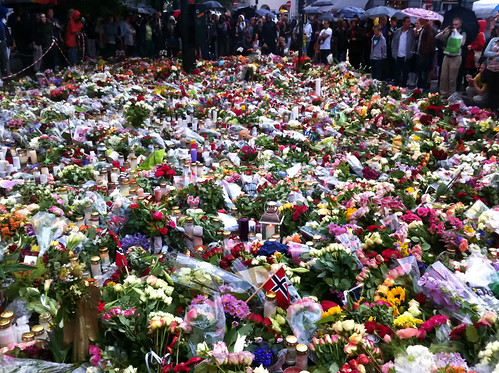
Looking back at the week’s news, the first news event that comes to mind is the tragedy in Norway. While the tragedy (the bombing in Oslo and mass-shooting at a camp run by the Labor Party on Utoya Island) itself is impossible to forget, this was a unique situation also in that the media’s response was very, very interesting. Not only did journalists get caught up in assumptions and guessing games, but they also continue to subtly detract from the underlying issues.
First let’s examine the usual suspects. The New York Times posted an article immediately after the bombing, that was updated several times during the day. Along with a description of the casualties and damage done, a headline on the website reported that an Islamic terrorist group was responsible. As more information became available, of course, the Times corrected themselves and provided details about Anders Behring Breivik. It was also stated that the previous Islamic group may not even exist. How ridiculous was this – a report was published in the “paper of record” that placed blame on an Islamic group that wasn’t even real? Had any research been done? Or had the pressure of providing news 24/7 made it impossible for even the Times journalists to do their real job –investigate and report what they knew to be true?
USAToday’s coverage of the events took a live-blog format, which was constantly updated as new information became available. While the paper itself did not make any early claims about who was behind the attacks, it linked to the NYTimes article, thus spreading the notion and giving it validity.
BBC also published an article stating general facts and reporting that while some had suspected Al-Qaeda, the focus had changed to “the possibility of domestic extremism.”
The other news source I selected was The Guardian – a politically liberal British daily newspaper, with an online readership second only to the Times. Only hours after the bomb explosion in Oslo, writer and editor Peter Beaumont had put out a complete article that explained why Islamist militants would attack Norway. While only barely acknowledging that no ties had been established yet, The Guardian managed to solidify that connection in readers’ minds by providing a lengthy list of reasons why Norway would be attacked by Islamic fundamentalists.
Finally, my fifth news source was AlJazeera (English). In this article, general facts about the explosions and shootings were reported, along with a statement towards the end that Norway had received threats from Al-Qaeda in previous years, and Libyan tyrant Muammar Gaddafi had also pledged revenge from Europe. AlJazeera placed the least blame of all the sources discussed, but definitely planted a seed in readers’ minds.
On the one hand, one can be inclined to say that all of these newspapers did not do anything wrong – as they were reporting the bombing/shooting, they took the next logical step: trying to figure out who was behind the events. Readers would obviously want to know these things.
I argue that in the race to “be the first” to release a news story or new information, these newspapers (and journalists) did not do their duty of reporting facts (to the best of their knowledge). On the contrary, pure speculation was passed off as “expert opinion,” each previous article cited by other newspapers to continue the circus show. They not only bought into but also helped encourage the Islamophobia that is already rampant in the Western world. The NY Times, in its attempt to “correct” the previous assumptions, stated: “Terrorism specialists said that even if the authorities ultimately ruled out Islamic terrorism as the cause of Friday’s assaults, other kinds of groups or individuals were mimicking Al Qaeda’s brutality and multiple attacks.” The fact that the terrorist in this situation was clearly a xenophobic, anti-Islamic white extremist was being twisted to bring the focus back to Islamic groups.
This brings me to my next point – in all of these articles (and the ones later added by all of the newspapers), the word “terrorist” and any variation of it only showed up until the identity of the attacker was revealed. Then, the subject was simply (or not simply) a “gunman” whose mental faculties needed to be tested. (I would cite sources for this but then I would have to cite every article I've read.) Articles acknowledge that Breivik is being charged with "terrorist activities" but never once state it blatantly.
The definition of the word “terrorist” according to Google, is “A person who uses terrorism in the pursuit of political aims.” Breivik is by all means, a terrorist. His own testimony in court, his writings prior to the terrorist attacks and his beliefs put on display on various social media highlight the fact that the attacks were motivated by his racist and anti-Labor political beliefs. Media like the Times, Guardian, BBC, etc, so-called “liberal” media are not acknowledging this fact. They are doing their readers a great disservice by failing to highlight a very important connection between the growing anti-Islamic sentiment in the world and these acts of violence. (This article written by Salon.com’s Glenn Greenwald elaborates on all these issues. This article from AlJazeera talks about growing anti-Islamic sentiment, in relation to the recent attacks.)
Media Truth # 1 states: the media are essential components of our lives. No one can argue against this fact. When it comes to the news, the media are even more essential. This is why it is even more disheartening when these essential components so easily direct us in the wrong direction. In the quest to understand the terrorist attacks that befell Norway, especially in the broader terms of the current political mood in Norway and Europe, the people needed the media, specifically the news media. The media in this case misled its readers and viewers, sometimes willingly– and well, that’s pretty depressing.
No comments:
Post a Comment
Note: Only a member of this blog may post a comment.